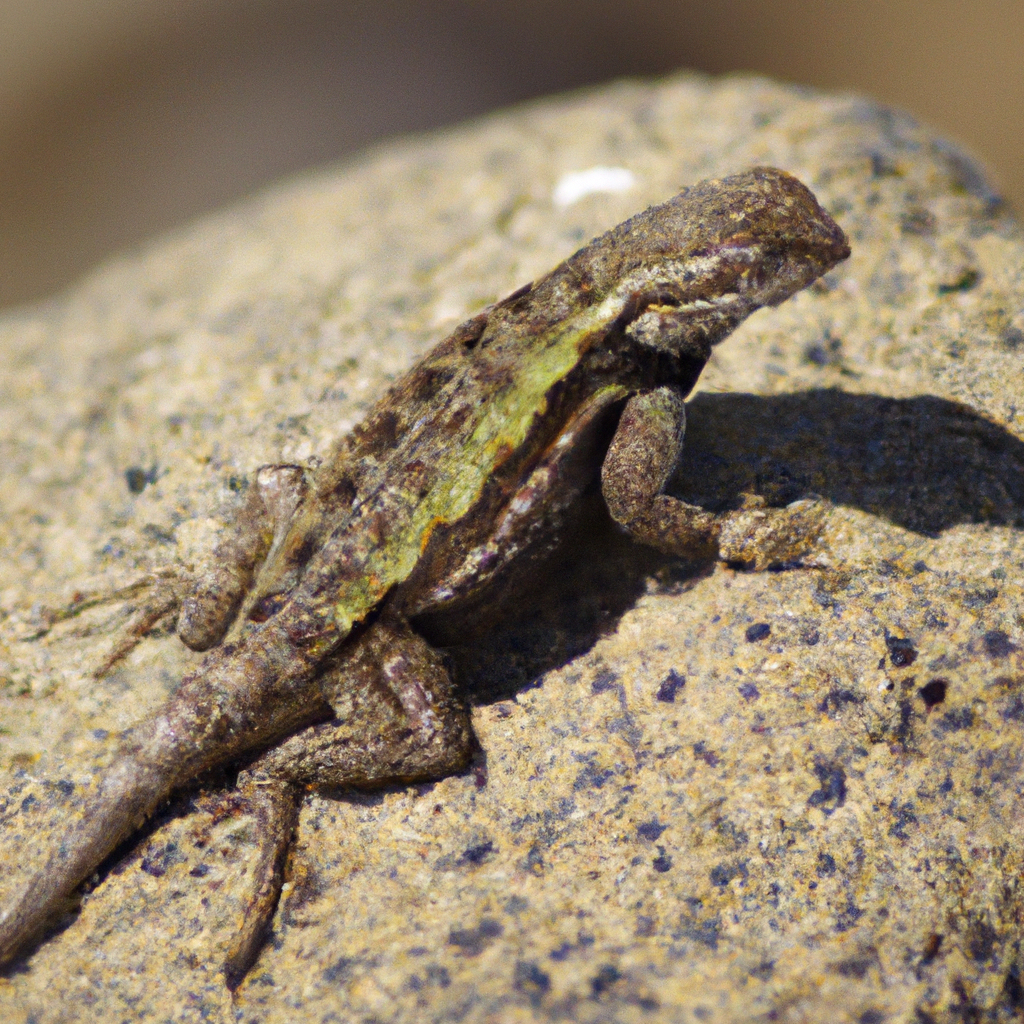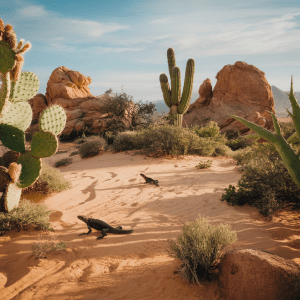Introduction to Lizards in North America
Lizards in North America are a fascinating and diverse group of reptiles that inhabit various ecosystems across the continent. From the arid deserts of the Southwest to the lush forests of the Southeast, North America is home to a wide range of lizard species, each with its own unique characteristics and adaptations.
One of the defining features of lizards in North America is their incredible diversity. With over 200 species found in the region, these reptiles come in a variety of shapes, sizes, and colors. From the tiny Western banded gecko to the impressive Gila monster, North American lizards showcase a remarkable range of adaptations that have allowed them to thrive in different environments.
North American lizards can be found in a wide array of habitats, including deserts, grasslands, forests, and even urban areas. Some species are adept climbers, while others are skilled burrowers. Their ability to blend into their surroundings and their impressive agility make them fascinating creatures to observe in the wild.
In addition to their physical diversity, North American lizards play important roles in their respective ecosystems. As predators, they help control insect populations, while also serving as prey for larger predators. Their presence is indicative of the health of the environment, making them valuable indicators of ecosystem stability.
Overall, the world of lizards in North America is a rich and complex one, filled with unique species and fascinating behaviors. By learning more about these reptiles and their habitats, we can gain a deeper appreciation for the incredible biodiversity that exists in our own backyard.
Diversity of Lizard Species in the Region
North America is home to a diverse range of lizard species, each uniquely adapted to its environment. From the deserts of the Southwest to the forests of the Pacific Northwest, lizards can be found in various habitats across the continent. One of the most fascinating aspects of the lizards in North America is their wide variety of colors, shapes, and sizes. Some species, like the iconic Gila monster, boast vibrant patterns and colors that serve as a warning to potential predators.
In addition to their visual diversity, North American lizards also exhibit a wide range of behaviors and adaptations. For example, the horned lizard, also known as the “horny toad,” has evolved a unique defense mechanism of shooting blood from its eyes to deter predators. Meanwhile, the agile anole lizard can change its color to match its surroundings, providing camouflage from predators.
The habitats of North American lizards are equally diverse, with species occupying niches ranging from rocky outcrops to sandy dunes. Some lizards, such as the collared lizard, are adept climbers that inhabit rocky cliffs and boulders, while others, like the desert iguana, are well adapted to the arid conditions of desert environments.
Overall, the diversity of lizard species in North America reflects the continent’s varied landscapes and climates. Studying these fascinating creatures not only provides insights into their biology and ecology but also underscores the importance of preserving their habitats for future generations to appreciate and enjoy.
Characteristics and Habitats of North American Lizards
Lizards in North America exhibit a wide range of characteristics and inhabit diverse ecosystems across the continent. From the arid deserts of the Southwest to the lush forests of the Southeast, these reptiles have adapted to various environments. North American lizards come in different sizes, colors, and shapes, reflecting the unique conditions of their habitats.
One key characteristic of North American lizards is their ability to regulate body temperature through thermoregulation. Many species are ectothermic, meaning they rely on external sources of heat to maintain their body temperature. This adaptation allows them to thrive in environments with fluctuating temperatures, such as deserts where daytime heat gives way to cooler nights.
The habitats of North American lizards also play a crucial role in shaping their characteristics. Some species are well adapted to rocky outcrops, blending seamlessly with their surroundings to evade predators. Others prefer open grasslands where they can bask in the sun and hunt for insects. Wetlands and marshes provide a home for species that thrive in humid conditions.
Furthermore, the diversity of North American lizard species extends to their diet preferences. While many lizards are insectivores, feeding on a variety of insects and spiders, others may consume plants, small mammals, or even other lizards. Their diet choices are closely tied to their habitat and hunting strategies, showcasing the adaptability and resourcefulness of these reptiles.
Overall, the characteristics and habitats of North American lizards highlight the fascinating adaptations and ecological roles of these reptiles in the region’s diverse ecosystems.
Popular Lizard Species in North America
North America boasts a rich variety of lizard species, each unique in its characteristics and adaptations to diverse environments. Among the popular lizard species in the region are the Western Fence Lizard, known for its blue belly and spiky scales, and the iconic Horned Lizard, recognized for its distinctive horned appearance. The colorful Collared Lizard, often found basking on rocks in the southwestern United States, is another well-loved species among lizard enthusiasts.
The Gila Monster, a venomous lizard with a striking orange and black pattern, is native to the deserts of the American Southwest and Mexico. Its venomous bite and slow-moving nature make it a fascinating yet elusive creature to observe in the wild. The regal Chuckwalla, with its stocky build and impressive climbing abilities, is a sight to behold in the rocky landscapes of the southwestern United States.
North America is also home to the charismatic Anole lizards, known for their ability to change colors based on their mood and environment. These small and agile lizards are commonly found in the southeastern United States and the Caribbean islands, adding a touch of vibrancy to their surroundings.
From the deserts of the southwest to the forests of the northeast, North American lizard species showcase a remarkable array of adaptations and behaviors. Whether you’re a seasoned herpetologist or a nature enthusiast looking to appreciate the biodiversity of the region, exploring the diverse lizard species of North America is sure to offer a fascinating glimpse into the world of reptiles.
Lizard Watching Locations in North America
North America offers a plethora of diverse habitats that are home to a wide variety of lizard species. For avid nature enthusiasts and wildlife lovers, exploring lizard watching locations in this region can be a rewarding and fascinating experience. From arid deserts to lush forests, North America’s landscapes provide ideal environments for different species of lizards to thrive.
One of the popular lizard watching locations in North America is the Sonoran Desert, spanning parts of Arizona, California, and Mexico. Here, you can spot iconic species such as the Gila monster and the desert spiny lizard against the backdrop of the desert’s unique flora and rock formations. Another noteworthy destination is the Florida Everglades, known for its rich biodiversity including the colorful anole lizards and the elusive green iguanas.
For those seeking a more rugged terrain, the canyons and mesas of the American Southwest offer opportunities to observe the agile collared lizards and the cryptic horned lizards. Additionally, the coastal regions of California provide habitats for the Western fence lizard and the charismatic blue-bellied fence lizard.
Whether you prefer the arid landscapes of the desert or the lush greenery of the forests, North America’s lizard watching locations cater to a range of interests and preferences. By exploring these diverse environments, you can witness the beauty and adaptability of North American lizards in their natural habitats, making each lizard watching excursion a memorable and educational experience.
Conservation Efforts for North American Lizards
Conservation efforts for North American lizards play a crucial role in preserving the biodiversity and ecosystems where these fascinating reptiles thrive. Due to various threats such as habitat loss, climate change, pollution, and poaching, many lizard species in North America are facing significant challenges to their survival.
Several organizations, researchers, and conservationists are actively involved in initiatives to protect and conserve North American lizards. These efforts often focus on habitat restoration, establishment of protected areas, and raising awareness about the importance of these reptiles in the ecosystem. By studying the behavior, population dynamics, and habitat requirements of different lizard species, conservationists can develop effective strategies to safeguard their populations.
One key aspect of conservation efforts for North American lizards is the monitoring of populations to track population trends, identify potential threats, and assess the effectiveness of conservation measures. This monitoring often involves field surveys, data collection, and collaboration with local communities to gather valuable information about lizard populations and their habitats.
Additionally, educational programs and outreach activities are essential for raising public awareness about the significance of lizards in North America and the importance of conserving their natural habitats. By engaging with the public, conservationists can inspire individuals to take action to protect these unique reptiles and the environments they depend on for survival.
Overall, conservation efforts for North American lizards are essential for ensuring the long-term viability of these species and maintaining the rich biodiversity of the region’s ecosystems. Through collaborative conservation initiatives and community involvement, we can work together to protect and preserve the diverse array of lizards that call North America home.
Behavior and Diet of North American Lizards
North American lizards exhibit a fascinating array of behaviors and dietary preferences that contribute to their unique ecological roles. These reptiles display a wide range of behaviors, from basking in the sun to engaging in territorial displays and mating rituals. Understanding the behavior of North American lizards can provide valuable insights into their lifestyles and interactions within their environments.
In terms of diet, North American lizards are known to be opportunistic feeders, consuming a variety of insects, small vertebrates, plants, and even fruits. Different species of lizards have evolved distinct feeding strategies based on their habitats and available food sources. Some lizards are carnivorous, preying on insects and other small animals, while others are herbivorous, relying on vegetation for sustenance.
Moreover, the dietary preferences of North American lizards play a crucial role in shaping their ecosystems. By controlling insect populations or dispersing seeds through their feeding habits, lizards contribute to the overall balance of their habitats. Understanding the dietary habits of these reptiles can provide valuable insights into the intricate web of interactions that exist within North American ecosystems.
Overall, delving into the behavior and diet of North American lizards offers a deeper appreciation for the diversity and complexity of these fascinating creatures. By studying their behaviors and dietary preferences, researchers and enthusiasts alike can gain a better understanding of the important roles that lizards play in maintaining the ecological balance of North America’s diverse landscapes.
Tips for Identifying Lizards in North America
Identifying lizards in North America can be a fascinating and rewarding experience for nature enthusiasts and wildlife lovers. To correctly identify these reptiles, it is crucial to pay attention to various physical characteristics and behaviors that are unique to each species. One key aspect to look for is the lizard’s size and shape, as different species vary significantly in their body structures. Some lizards are small and slender, while others are larger and more robust.
Another important factor in identifying North American lizards is their coloration and patterns. Lizards often have distinct colors and markings that can help differentiate one species from another. Paying attention to the patterns on their scales, the color of their skin, and any distinctive markings such as stripes or spots can provide valuable clues for identification.
Furthermore, observing the habitat in which the lizard is found can also aid in identification. Certain species of lizards prefer specific habitats such as deserts, forests, grasslands, or rocky areas. Understanding the preferred environment of different lizard species can help narrow down the possibilities when trying to identify a particular lizard.
Additionally, behavior can offer important clues for identification. Some lizards are more active during the day (diurnal), while others are active at night (nocturnal). Observing how a lizard moves, hunts for food, or interacts with its surroundings can provide valuable insights into its species.
By combining observations of size, shape, coloration, habitat, and behavior, enthusiasts can enhance their ability to identify and appreciate the diverse range of lizards that inhabit North America.
Importance of Lizards in the Ecosystem
Lizards play a crucial role in the ecosystem of North America, contributing to the delicate balance of nature in various ways. As important predators, lizards help control insect populations, including pests that can harm crops and vegetation. By preying on insects such as crickets, grasshoppers, and beetles, lizards assist in maintaining ecological harmony and preventing crop damage.
Moreover, lizards themselves serve as a food source for many predators, such as birds of prey and mammals, thereby forming a vital link in the food chain. Their presence supports the survival and reproduction of higher-level predators, ensuring a healthy and functioning ecosystem. Additionally, lizards are known to be effective seed dispersers, aiding in the propagation of plants and contributing to the biodiversity of their habitats.
Furthermore, the diverse behaviors and adaptations of North American lizards provide valuable insights for scientific research and conservation efforts. Studying their unique physiological features, reproductive strategies, and responses to environmental changes helps researchers better understand the impact of human activities on wildlife populations and ecosystems. This knowledge is essential for developing effective conservation plans to protect lizards and their habitats for future generations.
In conclusion, the importance of lizards in the ecosystem of North America cannot be overstated. From controlling insect populations to serving as prey for other species and contributing to plant diversity, lizards play a vital role in maintaining the ecological balance of their habitats. By appreciating and conserving these fascinating creatures, we can ensure the continued health and sustainability of the natural world.
Conclusion: Appreciating the Lizard Diversity in North America
The diverse range of lizard species found in North America plays a crucial role in the ecosystem. Lizards are integral components of their respective habitats, contributing to the balance of predator-prey relationships and ecosystem dynamics. By consuming insects and other small animals, lizards help regulate populations, preventing potential imbalances that could arise from unchecked growth.
Furthermore, lizards serve as important indicators of environmental health. Their presence or absence in an area can provide valuable insights into the overall well-being of the ecosystem. Monitoring lizard populations can help researchers assess the impact of environmental changes, such as habitat destruction or climate fluctuations, on biodiversity and ecosystem stability.
In addition to their ecological significance, lizards also hold cultural and educational value. Many people find fascination in observing these reptiles in their natural habitats, sparking interest in wildlife conservation and environmental awareness. Lizards are often featured in educational programs and nature documentaries, highlighting their unique adaptations and behaviors.
As we continue to learn more about the importance of biodiversity and the interconnectedness of species within ecosystems, it becomes clear that lizards in North America are more than just fascinating creatures—they are key players in maintaining the health and balance of the natural world. By appreciating the diversity of lizards in North America, we gain a deeper understanding of the intricate web of life that surrounds us and the need to protect and preserve these valuable species for future generations.




